Gas Turbine Engines
-
- $3-Million Surface Effect Ship Award To Philadelphia Gear Maritime Reporter, Nov 15, 1977 #24
Philadelphia Gear of King of Prussia, Pa. 19406, has been chosen to design, manufacture and test the propulsor reduction gearbox for the 3,000-ton Surface Effect Ship (3KSES). The planned cost for this effort through design, development, test and delivery of one ship set of four propulsor r e d u c t i o n gearboxes, plus one development propulsor, will exceed $3,000,000 in the next four years.
An SES is a marine vessel that operates on a cushion of air to significantly reduce its drag. As a result of the reduced drag, a large SES can be propelled at speeds ranging up to 100 knots.
By comparison, conventional ships have maximum speed limitations, depending on size, mission, hull configuration, etc., of less than half that of the SES.
The Navy's 3,000-ton Surface Effect Ship Program represents the culmination of 15 years of research and development to produce an oceangoing operational surface effect ship prototype. Advanced ships of this type are capable of extraordinarily high speeds, since they ride over the water on a cushion of air contained under the ship.
The 3KSES design has an approximate length of 270 feet, a maximum beam of about 105 feet, and a cushion height of 18 feet.
The ship will be able to carry a crew of 125 men at speeds three times that of conventional ships.
For propulsion, General Electric LM 2500 gas turbine engines will drive four Aerojet water jet propulsors.
Cushion air will be provided by six Aerojet centrifugal fans powered by two LM 2500 gas turbine engines. The ship will be equipped with helicopters and/or V/STOL aircraft, as well as weapons and sensors for test purposes.
Philadelphia Gear was selected because of its experience in large marine gearbox fabrication for the U.S. Navy and shipbuilders throughout the world. Their experience includes fabrication of supercavitating propellers used on the U.S. Navy 100-ton Surface Effect Ship that recently set a speed record of 103 mph. The award is by the Aerojet Liquid Rocket Company of Sacramento, Calif., under a subcontract from Rohr Marine Incorporated, a subsidiary of Rohr Industries, Inc. of Chula Vista, Calif.
-
- Allison Gas Turbines Will Power World's Fastest Patrol Boat Maritime Reporter, Apr 1985 #111
of airplanes and fast patrol craft. The H-3 (shown above) is a water jet, three-engine vessel powered by Detroit Diesel Allison gas turbine engines driving water jets supplied by KaMeWa AB of Sweden, through Cincinnati Gear Company's epicyclic reduction gears. The patrol boat has an
-
- Pentagon Approves $216-Million Sale To Portugese Navy Maritime Reporter, Jun 1986 #12
and 24 Seasparrow missiles; three Phalanx guns to protect against cruise missile attacks; 72 MK-46 torpedoes and torpedolaunching systems; six advanced gas-turbine engines; associated communications gear; and spare parts. The sale, which will be overseen by the U.S. Navy, involves the following prime
-
- Rohr Outlines Plans For Design, Construction And Component Testing Of 3,000-Ton Navy SES Maritime Reporter, Feb 1977 #7
. The ship will be able to carry a crew of 125 men at speeds three times that of conventional ships. For propulsion, General Electric LM 2500 gas turbine engines will drive waterjet propulsors. Cushion air will be provided by six centrifugal fans powered by two LM 2500 gas turbine engines. The ship
-
- The US Government Must Fund Icebreakers Now Maritime Reporter, Mar 2018 #12
has gone through a service life extension. Polar icebreakers operate in extreme conditions. Polar Star regularly uses its three 25,000 horsepower gas turbine engines to drive its 13,000 ton hull into pack ice. If the ice is thick and hard, and if there is little open water nearby, as is often the case, the
-
- U.S. Export Reform: New Year, New Rules Maritime Reporter, Dec 2013 #18
are USML Categories VI and XX and CCL Category 8, it should be noted that effective January 6, 2014, amendments to Category 9 of the CCL will affect gas turbine engines for surface vessels, and the revised Category XIII will contain controls related to ship signature management. In addition, as in the past
-
- Solar To Design Advanced Cruise Propulsion System For U.S. Navy Maritime Reporter, Apr 1980 #56
e d RACER (Rankine-Cycle E n e r g y Recovery), the program calls for Solar to design a system that will capture heat energy from a ship's main gas turbine engines. The heat will produce steam that will provide additional power to the ship's propellers via steam turbines. Such a system will enable the vesse
-
- USS H a r r y W . Hill Commissioned At Ingalls S h i p b u i l d i ng Maritime Reporter, Jan 1980 #27
for antisubmarine warfare. Fast, highly maneuverable and extremely quiet, they are the first major U.S. combat ships to be powered by gas turbine engines. Four marine jet engines produce more than 80,000 shaft horsepower to drive each ship at speeds in excess of 30 knots. In addition to antisubmari
-
- Radiance of the Seas — A First Class Delivery Maritime Reporter, Apr 2001 #26
slim, yacht like design with many glazed fronts, the ship is driven by an azipod propulsion system, and powered by smokeless, vibration-free GE gas turbine engines. Built according to DNV Classification standards. Radiance was designed in close cooperation with its owners and optimized via computer
-
- Maritime Industry Remembers Nealis Maritime Reporter, Jun 2002 #97
were the co-conception, testing and first at sea of a commercially viable demonstration of a blended residual fuel system for aero derived gas turbine engines. In addition, he served as the Owner's Representative for the conversion and operation of the 112,000-ton supertanker, S.S. Manhattan, which
-
- Garrett Division To Participate In Design Of New Engine For Mid-Sized Navy Ships Maritime Reporter, Mar 1986 #68
use. Both AiResearch and Rolls Royce have recently conducted funded studies for the U.S. Navy on the design of intercooled and regenerated gas turbine engines. These studies helped lead the way to the conceptual design award. It is expected that the current program will lead to a multimillion-dollar
-
- Ingalls Christens 1 1 t h Aegis G u i d e d Missile Cruiser For N a vy Maritime Reporter, Dec 1987 #50
, was the ship's sponsor. The Princeton is 567 feet long, with a beam of 55 feet, and displaces 9,500 tons. She is powered by four GE gas turbine engines, which power the cruiser to speeds of more than 30 knots. The Princeton is equipped with the MK 41 vertical launching system, a multiwarfare
-
 )
March 2024 - Marine Technology Reporter page: 37
)
March 2024 - Marine Technology Reporter page: 37(sg=1.026) and lighter than the battery electrolyte (sg=1.265). The original cell vent cap was screwed into the top of the riser pipe to vent the gases associated with charging. Wires were soldered to the lead (Pb) posts. The lead-acid battery was additionally used as an expendable ballast weight
-
 )
March 2024 - Marine Technology Reporter page: 36
)
March 2024 - Marine Technology Reporter page: 36battery packs, di- If sealed with a rubber diaphragm, the battery must be vent- vided into three buses. The sub could operate off a single ed to manage gases formed during charging. (Myers, 1968) bus in emergency mode. All power and control signals were An innovative means of pressure compensation was
-
 )
March 2024 - Marine Technology Reporter page: 33
)
March 2024 - Marine Technology Reporter page: 33regulated industry in the world.” How- ever, commercial success depends on many factors, not least a predictable OPEX. Over the past four years, SMD has worked with Oil States Industries to calculate cost per tonne ? gures for prospective customers. Patania II uses jet water pumps to Oil States’
-
 )
March 2024 - Marine Technology Reporter page: 25
)
March 2024 - Marine Technology Reporter page: 25SYSTEM just mapped. I have ‘discovered’ many mountains, hills, valleys and canyons that APPLICATIONS would rival anything seen on land.” • Shallow Gas Hazard Surveys • Oi shore Wind Turbine Phase two, mapping inside the caldera, • Geotechnical InvesO gaO on • Sand Resource InvesO gaO
-
 )
March 2024 - Marine Technology Reporter page: 15
)
March 2024 - Marine Technology Reporter page: 15sensor options for longer mission periods. About the Author For glider users working in ? sheries and conservation, Shea Quinn is the Product Line Manager the Sentinel can run several high-energy passive and active of the Slocum Glider at Teledyne Webb acoustic sensors, on-board processing, and imaging
-
 )
March 2024 - Marine Technology Reporter page: 14
)
March 2024 - Marine Technology Reporter page: 14TECH FEATURE TELEDYNE SLOCUM GLIDERS to hold over 3.5 times as many lithium primary batteries as the the water column and its thrusters give it the ability to stay standard Slocum Glider, and to physically accommodate up to on track in strong currents or other dif? cult ocean condi- 8 different sensor
-
 )
March 2024 - Marine Technology Reporter page: 13
)
March 2024 - Marine Technology Reporter page: 13nyone familiar with glider hardware options integrated for a broad Glider answers that need,” said Shea autonomous underwater ve- range of missions. Quinn, Slocum Glider Product Line hicles (AUVs) is certainly “As the use of Slocum Gliders grew, Manager at TWR. A familiar with the popular- so did
-
 )
April 2024 - Maritime Reporter and Engineering News page: 43
)
April 2024 - Maritime Reporter and Engineering News page: 43“The industry is an ecosystem which includes owners, managers, mariners, shipyards, equipment makers, designers, research institutes and class societies: all of them are crucial,” – Eero Lehtovaara, Head of Regulatory & Public Affairs, ABB Marine & Ports All images courtesy ABB Marine and Ports provi
-
 )
April 2024 - Maritime Reporter and Engineering News page: 42
)
April 2024 - Maritime Reporter and Engineering News page: 42indicator (CII) meeting the shipping industry’s goal for id advances in digital technology are and EU Emissions Trading Scheme are net-zero greenhouse gas emissions by changing the way ships are operated. only early milestones on the regulatory around 2050. He also believes maritime “The maritime education
-
 )
April 2024 - Maritime Reporter and Engineering News page: 38
)
April 2024 - Maritime Reporter and Engineering News page: 38Consulmar Crowley's New LNG Containerships Carbon Capture @ Sea Crowley shared ? rst renderings and the names of its four new dual fuel lique? ed natural gas (LNG)-powered containerships: Quetzal, Copan, Tiscapa and Torogoz. The 1,400 TEU ves- sels were ordered in 2022 by Singapore-based Eastern Paci? c
-
 )
April 2024 - Maritime Reporter and Engineering News page: 35
)
April 2024 - Maritime Reporter and Engineering News page: 35environment, which in turn can from vessel drawings. The academy program also includes reduce the time they need to spend on a simulator. This saves gas handling operations and engine room simulation courses time and money and frees up simulator time for others. offered by GTT Training and the Thet
-
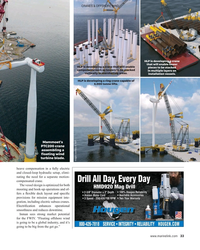 )
April 2024 - Maritime Reporter and Engineering News page: 33
)
April 2024 - Maritime Reporter and Engineering News page: 33CRANES & OFFSHORE WIND HLP is developing a crane that will enable tower HLP is developing a crane that will enable pieces to be stacked components such as towers to be stacked in multiple layers on vertically in marshalling areas. installation vessels. HLP is developing a ring crane capable of 6
-
 )
April 2024 - Maritime Reporter and Engineering News page: 32
)
April 2024 - Maritime Reporter and Engineering News page: 32wind. The subsidies won’t be a plentiful, and then a second on a luf? ng jib. This reduces the time it would there won’t be the same downturn in oil and gas that made all ordinarily take, weeks, to recon? gure the wiring of an ordi- the high-spec construction vessels available at attractive rates, nary
-
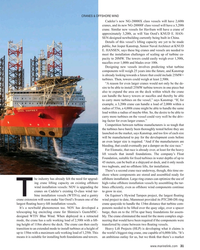 )
April 2024 - Maritime Reporter and Engineering News page: 31
)
April 2024 - Maritime Reporter and Engineering News page: 31CRANES & OFFSHORE WIND Cadeler’s new NG-20000X class vessels will have 2,600t cranes, and its new NG-20000F class vessel will have a 3,200t crane. Similar new vessels for Havfram will have a crane of approximately 3,200t, as will Van Oord’s KNUD E. HAN- SEN-designed newbuilding currently being built in
-
 )
April 2024 - Maritime Reporter and Engineering News page: 25
)
April 2024 - Maritime Reporter and Engineering News page: 25old or older and need to be that are government owned and operated ships, government replaced. We’re talking all the way from steam to diesel and some gas turbines. The commercial world doesn’t use owned and contract operated, and contract owned and con- steam any more, but we still have quite a few steam-pow-
-
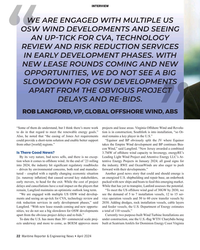 )
April 2024 - Maritime Reporter and Engineering News page: 22
)
April 2024 - Maritime Reporter and Engineering News page: 22INTERVIEW WE ARE ENGAGED WITH MULTIPLE US OSW WIND DEVELOPMENTS AND SEEING AN UP-TICK FOR CVA, TECHNOLOGY REVIEW AND RISK REDUCTION SERVICES IN EARLY DEVELOPMENT PHASES. WITH NEW LEASE ROUNDS COMING AND NEW OPPORTUNITIES, WE DO NOT SEE A BIG SLOWDOWN FOR OSW DEVELOPMENTS APART FROM THE OBVIOUS
-
 )
April 2024 - Maritime Reporter and Engineering News page: 21
)
April 2024 - Maritime Reporter and Engineering News page: 21with our continued support to the in a UK design ? rm working in the North Sea marine industry,” said Langford. “We continue to hire key in- oil and gas platforms, the holy grail of rigorous dividuals and partner to provide best-in-class solutions.” R conditions in offshore energy production. From
-
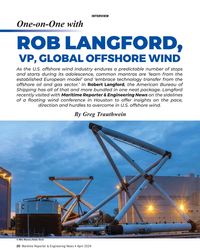 )
April 2024 - Maritime Reporter and Engineering News page: 20
)
April 2024 - Maritime Reporter and Engineering News page: 20starts during its adolescence, common mantras are ‘learn from the established European model’ and ‘embrace technology transfer from the offshore oil and gas sector.’ In Robert Langford, the American Bureau of Shipping has all of that and more bundled in one neat package. Langford recently visited with
-
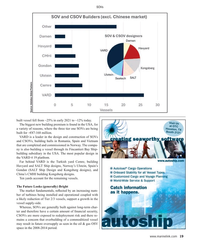 )
April 2024 - Maritime Reporter and Engineering News page: 19
)
April 2024 - Maritime Reporter and Engineering News page: 19exposed to redeployment risk and there re- mains a concern that overbuilding of a commoditized vessel may result in future oversupply as seen in the oil & gas OSV space in the 2008-2014 period. www.marinelink.com 19 MR #4 (18-33).indd 19 4/5/2024 8:13:37 A
-
 )
April 2024 - Maritime Reporter and Engineering News page: 18
)
April 2024 - Maritime Reporter and Engineering News page: 18MARKETS & gas activity returns, we anticipate that supply of the vessels The Question of Emissions to offshore wind projects will reduce, driving demand for ad- Given that SOVs and CSOVs operate in a segment target- ditional CSOVs. ing reduced emissions, and many operate in the North Eu- Outside of China
-
 )
April 2024 - Maritime Reporter and Engineering News page: 17
)
April 2024 - Maritime Reporter and Engineering News page: 17SOVs China, we do not look at demand for SOVs/CSOVs as having a linear rela- tionship to the number of wind farms or turbines installed. We look to see where a large number of wind turbines are concentrated in relatively close proximity, generally in a very large wind farm or in a project cluster
-
 )
April 2024 - Maritime Reporter and Engineering News page: 16
)
April 2024 - Maritime Reporter and Engineering News page: 16to a wind turbine OEM or offshore wind in-built crane and gangway. farm operator to service and maintain equipment dur- ¦Tier 2: Generally, oil & gas tonnage (MPSVs, PSVs, ing the operations period of the wind farm. A typical etc.) with ? xed gangway, serving oil & gas and SOV will accommodate
-
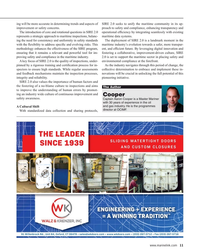 )
April 2024 - Maritime Reporter and Engineering News page: 11
)
April 2024 - Maritime Reporter and Engineering News page: 11culture of continuous improvement and Cooper safety awareness. Captain Aaron Cooper is a Master Mariner with 30 years of experience in the oil and gas industry. He is the programmes A Cultural Shift director at OCIMF. With standardized data collection and sharing protocols, THE LEADER SLIDING
-
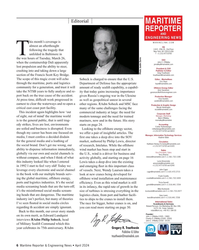 )
April 2024 - Maritime Reporter and Engineering News page: 6
)
April 2024 - Maritime Reporter and Engineering News page: 6Editorial MARITIME REPORTER AND ENGINEERING NEWS his month’s coverage is M A R I N E L I N K . C O M almost an afterthought HQ 118 E. 25th St., 2nd Floor following the tragedy that New York, NY 10010 USA T +1.212.477.6700 Tunfolded in Baltimore in the wee hours of Tuesday, March 26, CEO John C.
